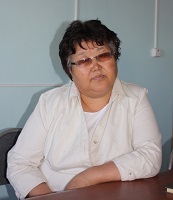Creating electronic resources on Tuvan language: preliminary results, current challenges and prospects
Keywords:
Tuvan language; electronic corpus of Tuvan language; National corpus of Tuvan language; corpus linguistics; corpus of texts; Pisateli Tuvy / Tyvanyң chogaalchylary; electronic textbook; information technologies; Research and Education Center of Turkic StuAbstract
At the moment, corpus linguistics is a rapidly developing field of studies, which, among everything else, plays a significant role in applied research. In the Republic of Tuva, debates on using information technologies in studying Tuvan language and literature studies began as far back as the 1990s, but a breakthrough cane in 2009, when the Research and Education Center of Turkic Studies was opened at Tuvan State University. As the Center’s director, in this article the author takes stock of the work done so far, sets new goals and describes the current challenges.
The Center works in collaboration with the Departments of IT at Tuvan State University and Siberian Federal University, as well as with foreign scientists – F.M. Tyers (University of Tromsø, Norway), J. Washington (Indiana University, Bloomington, USA). Among the projects already under way a special place belongs to the Electronic Corpus of Tuvan Language (www.tuvacorpus.ru). Current challenges include creating electronic textbooks on Tuvan language and literature for secondary school level (in compliance with the Federal State Standards of Education)
Another large-scale project spearheaded by the Center is the ‘Pisateli Tuvy / Tyvanyң chogaalchylary’ website (http://pisateli-tuvy.ru/). The list of its participants includes the Institute for the Development of Ethnic Schools in Tuva, innovative platforms of the Republic of Tuva, as well as several departments at Tuvan State University. When completed, the website will feature materials on over 100 Tuvan writers, including biographies, bibliographies, criticism, translations, opinion writing, scholarly papers, photos, audio recordings, presentation files and other pieces which will soon appear on their profile pages. The site will serve as a fundamental database of sources for other electronic educational resources, such as ‘The Electronic Library of Children’s Literature in Tuvan Language’, ‘Classic Works of Tuvan Literature’ and ‘Electronic School Library in Tuvan Language’.
Other promising projects worth mentioning include a corpus of Tuvan texts in various systems of writing (Tibetan, Old Mongolian, Sanskrit, Latin script and early 20th century Cyrillic), a corpus of parallel texts (Tuvan-Russian, Russian-Tuvan, Mongol-Tuvan, German-Tuvan, Tuvan-German, Tuvan-English, etc.), a corpus of proper names (databases of Tuvan placenames, personal names, gods of traditional Tuvan pantheon, names of celestial objects, pets, etc.), a corpus of various dictionaries, a corpus of dialects and that of folklore.
The present moment when the foundations of all these corpuses are just being laid is the right time to discuss their future and number. The National corpus of Tuvan language is one of those fundamental projects which can help preserve a language while the number of its active speakers is constantly decreasing.
References
Ageeva, E. and Taiers, F. (2016) Kombinirovannye morfologicheskie i sintaksicheskie neodnoznachnosti dlia sintaksicheskogo analiza zavisimostei kross-iazykov. Izvestiia Kyrgyzskogo gosudarstvennogo tekhnicheskogo universiteta im. I. Razzakova, no. 2 (38), pp. 112–121. (In Russ.).
Aranchyn, Iu. L. (1976) Ege sөs. In: Erniӊ ekizi Khan-Kharangui. Kyzyl, Tyvanyӊ nom үndүrer cheri. 118 p. (In Tuv.).
Bavuu-Siuriun, M. V. (2000) Vliianie russkogo iazyka na obrazovanie sovremennykh tuvinskikh familii i imen. In: Etnosotsial'nye protsessy v Sibiri, ed. Iu. V. Popkov. Vol. 3. Novosibirsk, Izd-vo SO RAN. 272 p. Pp. 204–205. (In Russ.).
Bavuu-Siuriun, M. V. (2016) Potentsial elektronnogo obrazovatel'nogo resursa «Tyvanyӊ chogaalchylary (Pisateli Tuvy)». In: Sokhranenie i razvitie iazykov i kul'tur korennykh narodov Sibiri: materialy IV Mezhdun. nauchno-prakt. konf. Abakan, Izd-vo FGBOU VPO «KhGU im. N. F. Katanova». Pp. 53–58. (In Russ.).
Published
How to Cite
Issue
Section

Author(s) license holder(s) grant rights for their work to the journal (grantee of a license) under the simple non-exclusive open license in accordance with Art. 1286.1 «Open license for a research work, work of literature or fine arts», Civil Code of the Russian Federation.
New Research of Tuva publishes articles under the Creative Commons Attribution-NonCommercial license (CC BY-NC).
Since it is an open license, author(s) reserve the right to upload the article to their institutional repository, submit it to another journal (if it allows republications), or republish it on their own website (in full, or in part).
However, several conditions apply here:
a) The republished version must always contain the name(s) and affiliation(s) of the author(s), the original title and the hyperlink to the original version on the New Research of Tuva website;
b) It must be in open access, free of charge, and no category of readers must be in any way whatsoever advantaged over general readership.
c) should the contribution be submitted elsewhere by its author(s) without substantial modification (30% or more of original text unchanged), the body of the article should contain a disclaimer that the original version was published in New Research of Tuva (with a link to the respective page)
The CC-BY-NC is a non-revocable license which applies worldwide and lasts for the duration of the work’s copyright.


 Candidate of Philology, Associate Professor and Director, Research and Education Center of Turkic Studies, Tuvan State University.
Candidate of Philology, Associate Professor and Director, Research and Education Center of Turkic Studies, Tuvan State University.

